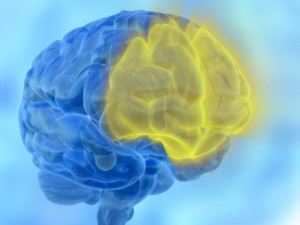Tagged: learning
Reopening Our Critical Period as Adults
 Ever wonder why children can learn certain things, such as languages, faster than adults? There is a time in every human’s life called the critical period, and it takes place during the most intense period of development, childhood. During this time a child’s brain has high neuroplasticity, almost like a sponge. Many new pathways are formed as the child experiences new things. It has always been believed that when our critical period ends it never comes back but recent study has been done with the drug Valproate that increased neural plasticity in adults and may have reopened this critical period.
Ever wonder why children can learn certain things, such as languages, faster than adults? There is a time in every human’s life called the critical period, and it takes place during the most intense period of development, childhood. During this time a child’s brain has high neuroplasticity, almost like a sponge. Many new pathways are formed as the child experiences new things. It has always been believed that when our critical period ends it never comes back but recent study has been done with the drug Valproate that increased neural plasticity in adults and may have reopened this critical period.
Valproate is a drug most commonly used for bipolar disorder and epilepsy. It is also known to inhibit an enzyme called histone- deacetylase, or HDAC. HDAC is an enzyme in the brain that slows down neural plasticity. Inhibition of this enzyme by Valproate allows the reopening of pathways in the brain, increasing neuroplasticity, thus reopening the critical period.
Don’t Panic! – Mice Aren’t Actually the Smartest
 "Man had always assumed that he was more intelligent than dolphins because he had achieved so much — the wheel, New York, wars and so on — whilst all the dolphins had ever done was muck about in the water having a good time. But conversely, the dolphins had always believed that they were far more intelligent than man — for precisely the same reasons....In fact there was only one species on the planet more intelligent than dolphins, and they spent a lot of their time in behavioural research laboratories running round inside wheels and conducting frighteningly elegant and subtle experiments on man. The fact that once again man completely misinterpreted this relationship was entirely according to these creatures' plans." - Douglas Adams, The Hitchhiker's Guide to the Galaxy
"Man had always assumed that he was more intelligent than dolphins because he had achieved so much — the wheel, New York, wars and so on — whilst all the dolphins had ever done was muck about in the water having a good time. But conversely, the dolphins had always believed that they were far more intelligent than man — for precisely the same reasons....In fact there was only one species on the planet more intelligent than dolphins, and they spent a lot of their time in behavioural research laboratories running round inside wheels and conducting frighteningly elegant and subtle experiments on man. The fact that once again man completely misinterpreted this relationship was entirely according to these creatures' plans." - Douglas Adams, The Hitchhiker's Guide to the Galaxy
As tempting as it may be to believe the science fiction version of the intelligence rankings, real-life science has spoken and suggests (much to my displeasure) that humans may actually be the highest on the intelligence scale.
Telepathic rats communicate via brain-to-brain connections

Scientists from Duke University and Brazil claim wires connecting one rodent to another can allow communication spanning continents via the internet. Professor Miguel Nicolelis of Duke University in Durham, North Carolina, led a team of researchers who demonstrated that it is possible to transmit instructions from one animal to another by brain-to-brain communication, a process akin to telepathy.
Brain-to-brain communication could be the start of organic-based computing based on networks of interconnected brains. Pairs of laboratory rats were able to communicate with each other using microscopic electrodes implanted into their brains. This occurred as part of an experiment where the two rats had to work together in order to receive a reward (see video at source).
Time to Mix it Up: The Student Guide to Good Study Habits
We’re told to find ourselves a quiet nook, to maintain a schedule, and to tackle one subject at a time. Our parents tell us that naps are a waste of time. And mass media conglomerates encourage us to fill every spare moment with a quick video clip or a two-minute game on our cell phones. But as it turns out, it is time to quit buying into what we’re told creates the optimal environment and habits to learn.
First, forget about holing up at that same seldom-visited spot over the span of time before an exam. Studies have found that students who vary where they study will remember the information better than those who stay in one place. The brain makes associations between what we study and where we study it, so the greater the number of associations, the more enriched the material, and the better entrenched the memory.

Experts advise students never to have a "go-to" study spot; changing locations can help students better learn the information.
Next, throw the one-subject-at-a-time approach out the window. Varying the type of material studied in one session has been shown to leave a deeper impression on the brain than focusing on a single topic at a time.
For example, a recent study in the journal of Applied Cognitive Psychology featured two groups of 4th graders being taught how to calculate the dimensions of a prism. There were four existing problem sets; one subject group was given repeated examples of one type of problem, while the other was given a mix of all four types of problems. A day later the groups were given separate tests on what they had learned, and the 4th graders who had been given the mixed problem sets performed twice as well.
Last but not least, when you have some down time, take the airplane approach: turn off all your electronics and take a nap. This technological age encourages nearly constant multitasking, but multitasking deprives our brains of much-needed rest. A continuous stream of digital input-via cell phones, iPods, computer screens, and televisions- forfeits the time when our minds could better learn and remember information, even form ideas.

Don't be this guy: Overloading your brain might appear to save you time, but in the end it impairs your learning abilities.
A study at UC-San Francisco found that rats do not process new information and transform it into a persistent memory until they are given a break from those new experiences. Thus in order for us to process what we’ve learned and experienced during the day, we need to rest our brains.
Recent studies have shown that sleep not only consolidates what you have already studied, but it also primes the mind for further learning. So an afternoon nap between classes (as long as you set your alarm) can actually be the final element to a perfect study system.
For Reference:
Think You Know How to Study? Think Again- NPR
Digital Devices Deprive Brain of Needed Downtime- The New York Times
Forget What You Know About Good Study Habits- The New York Times
Behavior: Napping Can Prime the Brain for Learning- The New York Times
Piano Teachers Must Be Neuroscientists
The familiar mantra “practice makes perfect” may be taken too literally. The definition of effective practice as the constant repetition of a particular exercise - a golf swing, a tennis serve, a dance step - is faulty, as it turns out.
Time has reported on a study published in Nature Neuroscience by neuroscientists at the University of Southern California and UCLA. The study compares the results of repetitive, “constant practice” with the results of “variable practice." In one experiment, scientists instructed a group of subjects to copy a movement with their forearm as displayed by a line on a computer screen. One group representing constant practice repeated a movement holding their arm at 60-degrees 120 times. The variable practice group was asked to do the same 60-degree movement only 60 times, but they were also asked to do three other movements 20 times each. The two groups did equally well in practice. However, when they were retested 24 hours later, the variable practice group outperformed the rote repetition group on the 60-degree task.
So, variable practice works - but why? Some of the subjects from each group were treated with transcranial magnetic stimulation (TMS). A portion of each group had TMS in the prefrontal cortex, and another portion received TMS in the primary motor cortex. The prefrontal cortex is the part of the brain that allows for executive functions like reasoning and planning while the primary motor cortex deals with simple, physical task learning. Fittingly, when the prefrontal cortices of variable-practice group members were “messed with” by TMS, the performance of the participants declined. Performance levels also decreased when constant-practice subjects underwent TMS in their primary motor cortices. It seems that “tedium is bad for the brain,” and it needs variety to actively learn by using higher structures like the prefrontal cortex to better retain what has been practiced.
It would be interesting to find out whether or not this concept applies to different types of learning, like studying for exams or playing an instrument. Even when training a dog, it is suggested to work amid distractions and to increase the time between clicking the “clicker” to let the dog know it has performed a task correctly and rewarding it with a treat. A higher level of focus seems to occur when there are more variables in the practice routine. My piano teacher must have been on to something when she gave me so much homework!
Study: Why Athletes Should Mix Sports-Training Routines - Time
Article: Practice Structure and Motor Memory -Nature Neuroscience
Opening Eyes to Learning Difficulties
![]()
Learning difficulty and disability has long been a problem for many children, parents and school teachers alike. Dysfunctions such as dyslexia and motor disability have hindered the progress of countless adolescents across the country and continue to do so with every passing day. Now, studies have been performed that may centralize learning difficulties to the eye, rather than the brain itself.
Researchers at the Norwegian University of Science and Technology are conducting research that creates a causal link between motor and learning disabilities and dysfunction in visual perception. For example, people who cannot quickly learn a simple motor task such as catching a ball may have difficulty because the cells in their eyes are not perceiving the stimulus properly. The same rings true in individuals with dyslexia - their eyes may not be correctly processing the visual stimuli of words on the page.

Learning disability has long puzzled victims, observers and scientists.
The ocular cells in contest here are deemed "magno cells" and detect rapid movements in our visual field, creating the movie-like perception we experience on a daily basis. Without these, life would look like a disconnected string of frames - much like a comic book. In a test conducted by the researchers, it was found that individuals with difficulty in mathematics also showed difficulty in tracking the randomized movement of a dot on a screen with their eyes, elucidating a link between eye function efficiency, detection of rapid changes in the environment and learning ability.
In a greater context, this finding may have implications in special education and may change the mindset of those working with individuals with additional learning needs. With this new information, learning disability can be combated from the angle of visual field perception. Techniques aiming to strengthen visual perception and eye efficiency (such as eye movement and tracking exercises) could act as a therapy for learning or motor disability previously thought to be localized in the brain itself.
Source: Science Daily via The Norwegian University of Science and Technology
